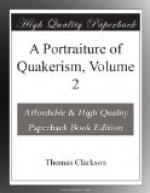[Footnote 2: It is sometimes buried without being carried there.]
SECT. II.
Quakers use no vaults in their burying-grounds—Relations sometimes buried near each other, but oftener otherwise—They use no tomb-stones or monumental inscriptions—Reasons for this disuse—But they sometimes record accounts of the lives, deaths, and dying sayings, of their Ministers.
The Quakers, in the infancy of their institution, were buried in their gardens, or orchards, or in the fields and premises of one another. They had at that time no grave-yards of their own; and they refused to be buried in those of the church, lest they should thus acknowledge the validity of an human appointment of the priesthood, the propriety of payment for gospel-labour, and the peculiar holiness of consecrated ground. This refusal to be buried within the precincts of the church, was considered as the bearing of their testimony for truth. In process of time they raised their own meeting-houses, and had their respective burying places. But these were not always contiguous, but sometimes at a distance from one another, The Quakers have no sepulchres or arched vaults under ground for the reception of their dead. There has been here and there a vault, and there is here and there a grave with sides of brick; but the coffins, containing their bodies, are usually committed to the dust.
I may observe also, that the Quakers are sometimes buried near their relations, but more frequently otherwise. In places where the Quaker-population is thin, and the burial ground large, a relation is buried next to a relation, if it be desired. In other places, however, the graves are usually dug in rows, and the bodies deposited in them, not as their relations lie, but as they happen to be opened in succession without any attention to family connexions. When the first grave in the row is opened and filled, the person who dies next, is put into that which is next to it; and the person who dies next, occupies that which is next to the second[3]. It is to many an endearing thought, that they shall lie after their death, near the remains of those whom they loved in life. But the Quakers, in general, have not thought it right or wise to indulge such feelings. They believe that all good men, however their bodies may be separated in their subterraneous houses of clay, will assuredly meet at the resurrection of the just.
[Footnote 3: By this process a small piece of ground is longer in filling, no room being lost, and the danger and disagreeable necessity of opening graves before the bodies in them are decayed, is avoided.]




